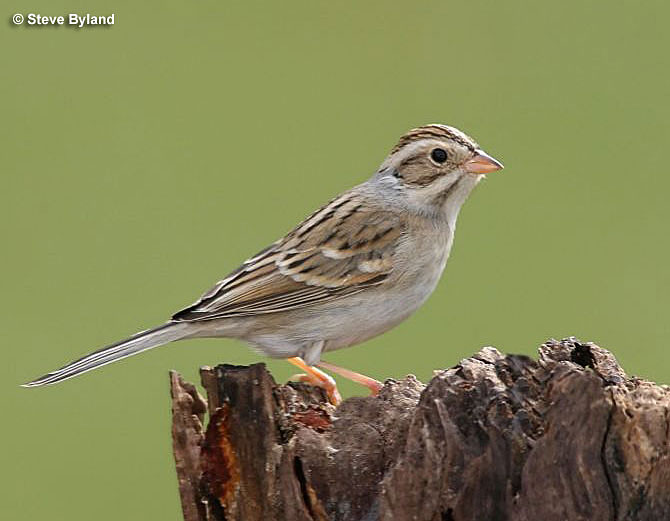The Clay-colored Sparrow breeds in shrub communities of the northern Great Plains and Prairie Provinces of Canada. Clay-colored Sparrow nests are frequently parasitized by Brown-headed Cowbirds. Cowbird eggs can either be accepted or rejected, but if they are accepted, only cowbirds are known to be raised.
Clay-colored Sparrow territories are small, and when feeding young, adults will forage outside of their territories. Chipping and Song Sparrows are usually confronted by territorial male Clay-colored Sparrows.
On this page
Description of the Clay-colored Sparrow
BREEDING MALE
The Clay-colored Sparrow has streaked, brownish upperparts, a plain gray nape, a bold white supercilium and median crown stripe bordered by dark stripes, plain, buffy-white underparts, and indistinct wing bars.

Photograph © Glenn Bartley.
Female
Sexes similar.
Seasonal change in appearance
Fall and winter birds are slightly buffier below.
Juvenile
Juveniles have streaked underparts.
Habitat
Clay-colored Sparrows inhabit brushy areas and woodland edges.
Diet
Clay-colored Sparrows eat insects and seeds.
Behavior
Clay-colored Sparrows forage on the ground or low in vegetation.
Range
Clay-colored Sparrows breed across much of central Canada and the north-central U.S. They winter in Mexico. During migration, they can be seen across a large section of the central U.S. The population appears to be stable.
Fun Facts
Clay-colored Sparrows are often seen in flocks during migration, sometimes with other sparrow species.
Adult Clay-colored Sparrows often forage outside of their territories during the nesting season.
Vocalizations
The song consists of a short series of buzzes. A short “wit” call is also given.
Similar Species
The Brewer’s Sparrow has a streaked nape and plainer head pattern.
Nesting
The Clay-colored Sparrow’s nest is a cup of grasses, weeds, and twigs and is lined with finer materials. It is placed on the ground or in a low shrub.
Number: Usually lay 3-5 eggs.
Color: Pale bluish-green with darker markings.
Incubation and fledging:
The young hatch at about 10-14 days, and fledge at about 7-9 days, though remaining dependent on the adults for some time.


